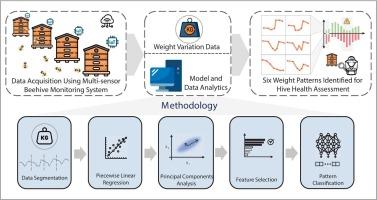Pattern analysis of daily beehive weight variation for colony health assessment
IF 8.9
1区 农林科学
Q1 AGRICULTURE, MULTIDISCIPLINARY
引用次数: 0
Abstract
Continuous monitoring of beehive conditions plays a crucial role in assessing colony health, improving productivity, and supporting effective beekeeping management. This study presents a data-driven framework for classifying daily hive weight variation patterns using a multi-sensor beehive monitoring system. Weight data were collected at 10-minute intervals and processed using piecewise linear regression to extract key features. Principal component analysis (PCA) and engineered features were used to reduce dimensionality and enhance interpretability. Six supervised learning models were evaluated using K-fold cross-validation. The Support Vector Classification (SVC) model achieved the highest performance in classifying daily weight variation patterns, with an F1-score of 0.905 using the nine most significant features, comprising seven weight points and two derived meaningful indicators − net daily weight change and harvested weight. The analysis revealed six common daily weight variation patterns, each reflecting distinct behavioral and environmental scenarios, such as active foraging, nectar scarcity, or post-feeding inactivity. Seasonal analyses further indicated clear relationships between these weight patterns and environmental conditions, confirming the method’s effectiveness in capturing colony behaviors and reflecting overall hive health. This study provides an effective and scalable approach for real-time hive health monitoring, contributing to the advancement of precision apiculture through the integration of smart sensing and machine learning.

蜂群健康评价中蜂箱日重变化模式分析
连续监测蜂箱状况在评估蜂群健康、提高生产力和支持有效养蜂管理方面起着至关重要的作用。本研究提出了一个数据驱动的框架,用于使用多传感器蜂窝监测系统对蜂窝日重变化模式进行分类。每隔10分钟收集一次权重数据,并使用分段线性回归进行处理,提取关键特征。采用主成分分析(PCA)和工程特征来降低维数,提高可解释性。使用K-fold交叉验证对六个监督学习模型进行评估。支持向量分类(SVC)模型在对日体重变化模式进行分类方面取得了最高的性能,使用9个最重要的特征,包括7个权重点和两个衍生的有意义指标-净日体重变化和收获体重,其f1得分为0.905。分析揭示了六种常见的每日体重变化模式,每种模式都反映了不同的行为和环境情景,如积极觅食、花蜜稀缺或喂食后不活动。季节分析进一步表明,这些体重模式与环境条件之间存在明确的关系,证实了该方法在捕捉蜂群行为和反映整体蜂巢健康方面的有效性。本研究提供了一种有效且可扩展的实时蜂箱健康监测方法,通过智能传感和机器学习的结合,为推进精准养蜂做出贡献。
本文章由计算机程序翻译,如有差异,请以英文原文为准。
求助全文
约1分钟内获得全文
求助全文
来源期刊

Computers and Electronics in Agriculture
工程技术-计算机:跨学科应用
CiteScore
15.30
自引率
14.50%
发文量
800
审稿时长
62 days
期刊介绍:
Computers and Electronics in Agriculture provides international coverage of advancements in computer hardware, software, electronic instrumentation, and control systems applied to agricultural challenges. Encompassing agronomy, horticulture, forestry, aquaculture, and animal farming, the journal publishes original papers, reviews, and applications notes. It explores the use of computers and electronics in plant or animal agricultural production, covering topics like agricultural soils, water, pests, controlled environments, and waste. The scope extends to on-farm post-harvest operations and relevant technologies, including artificial intelligence, sensors, machine vision, robotics, networking, and simulation modeling. Its companion journal, Smart Agricultural Technology, continues the focus on smart applications in production agriculture.
 求助内容:
求助内容: 应助结果提醒方式:
应助结果提醒方式:


